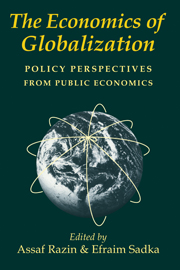Book contents
- Frontmatter
- Contents
- Preface
- List of Contributors
- Introduction
- I International Mobility of Technology
- II Capital Flows and Exchange-Rate Misalignment
- III Tax Incentives and Patterns of Capital Flows
- IV Limits to Income Redistribution in Federal Systems
- V Tax Harmonization, Tax Coordination, and the “Disappearing Taxpayer”
- VI Political-Economy Aspects of International Tax Competition
- VII Migration of Skilled and Unskilled Labor
- VIII Fiscal Aspects of Monetary Unification
- 16 The Interaction of Fiscal Policy and Monetary Policy in a Monetary Union: Balancing Credibility and Flexibility
- Index
16 - The Interaction of Fiscal Policy and Monetary Policy in a Monetary Union: Balancing Credibility and Flexibility
Published online by Cambridge University Press: 28 January 2010
- Frontmatter
- Contents
- Preface
- List of Contributors
- Introduction
- I International Mobility of Technology
- II Capital Flows and Exchange-Rate Misalignment
- III Tax Incentives and Patterns of Capital Flows
- IV Limits to Income Redistribution in Federal Systems
- V Tax Harmonization, Tax Coordination, and the “Disappearing Taxpayer”
- VI Political-Economy Aspects of International Tax Competition
- VII Migration of Skilled and Unskilled Labor
- VIII Fiscal Aspects of Monetary Unification
- 16 The Interaction of Fiscal Policy and Monetary Policy in a Monetary Union: Balancing Credibility and Flexibility
- Index
Summary
Introduction
The plans for a European monetary union (EMU) have motivated a growing body of research on the optimal design for a European central bank (ECB). A large part of that literature has drawn on the seminal work of Rogoff (1985), who showed that an optimally designed central bank would involve a trade-off between credibility and flexibility. Extending that type of analysis to a monetary union, Laskar (1989) investigated how the optimal degree of conservatism of the central bank would depend on the relative importance of common and idiosyncratic shocks. Alesina and Grilli (1992) focused on the degree of political independence of an ECB and the voting rules for appointment of the ECB board members. Von Hagen and Süppel (1994) also explored how the members of the central bank's council should be appointed or selected.
In contrast to monetary policy, fiscal policy will remain largely a national responsibility within the EMU. The analytical literature on European monetary unification has paid relatively little attention to the role of national fiscal policies and their interactions with the common monetary policy. The interaction between monetary policy and fiscal policy in a closed-economy setting with national monetary policy-making has been analyzed by Alesina and Tabellini (1987), Debelle (1993), and Debelle and Fischer (1994). This chapter draws on that literature to investigate how national fiscal policies will interact with the common monetary policy in an EMU. In fact, in the tradition of Phelps (1973) and Alesina and Tabellini (1987), we shall explore the role of monetary policy from a public-finance perspective.
- Type
- Chapter
- Information
- The Economics of GlobalizationPolicy Perspectives from Public Economics, pp. 373 - 406Publisher: Cambridge University PressPrint publication year: 1999
- 3
- Cited by



